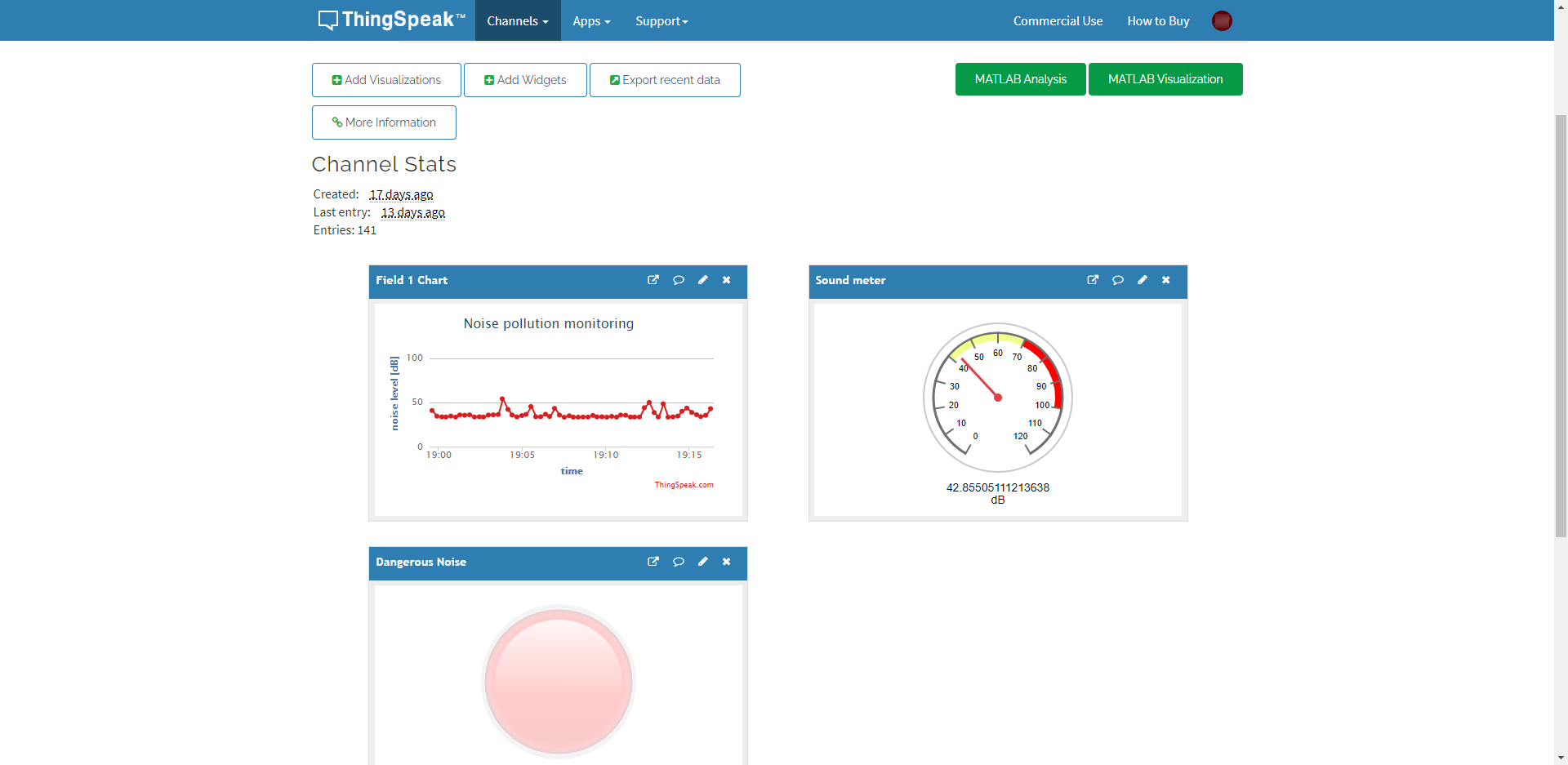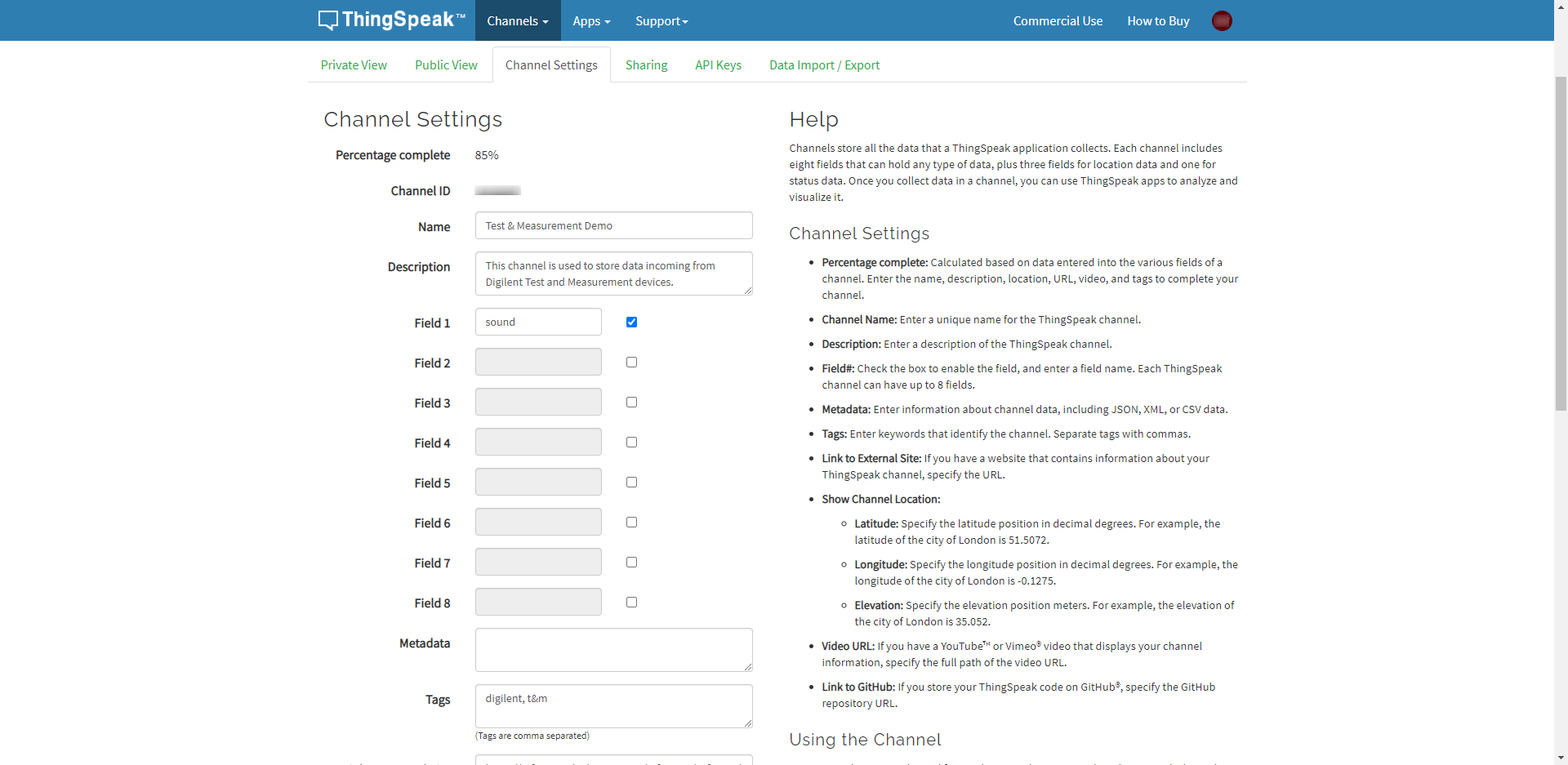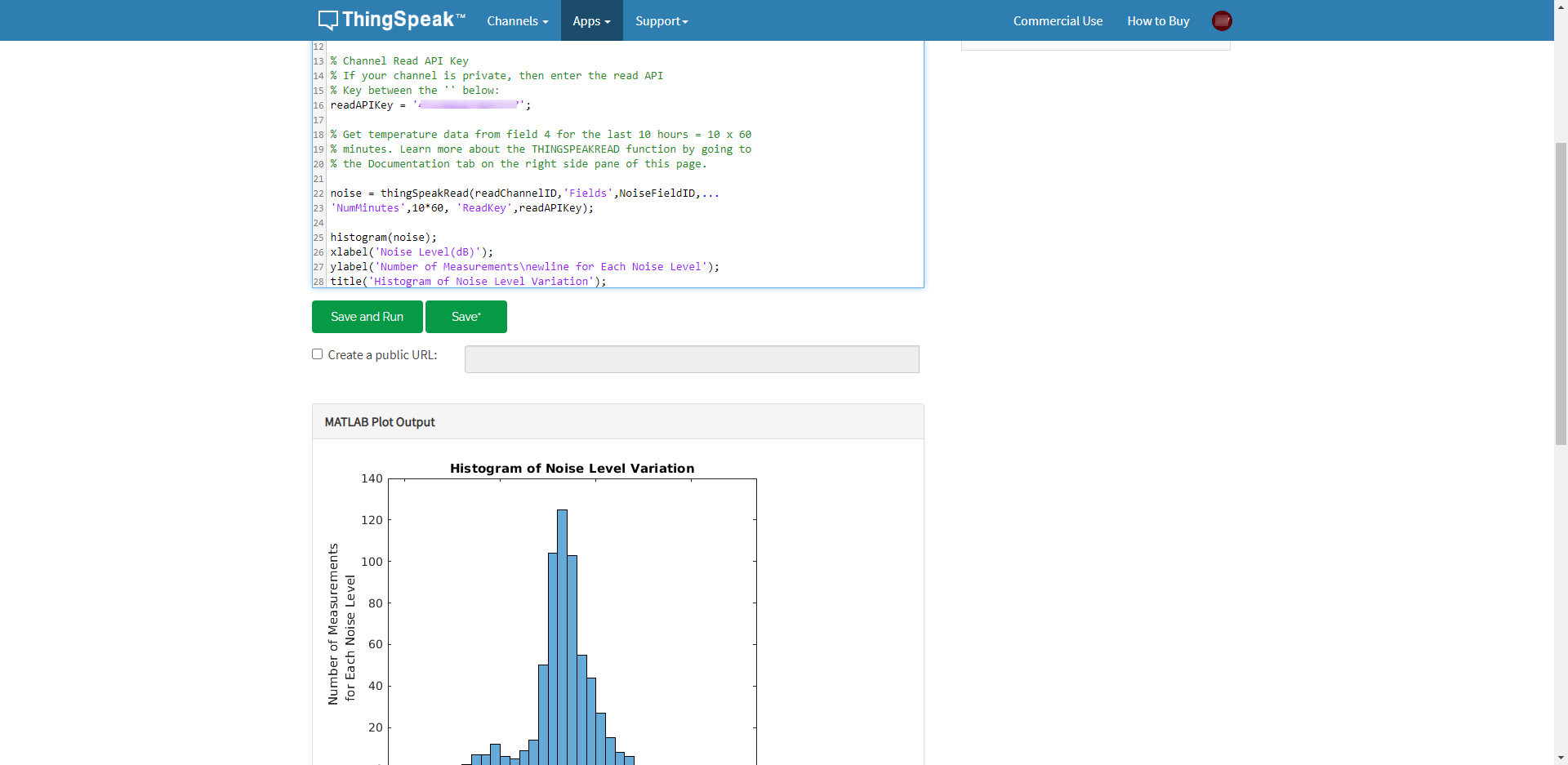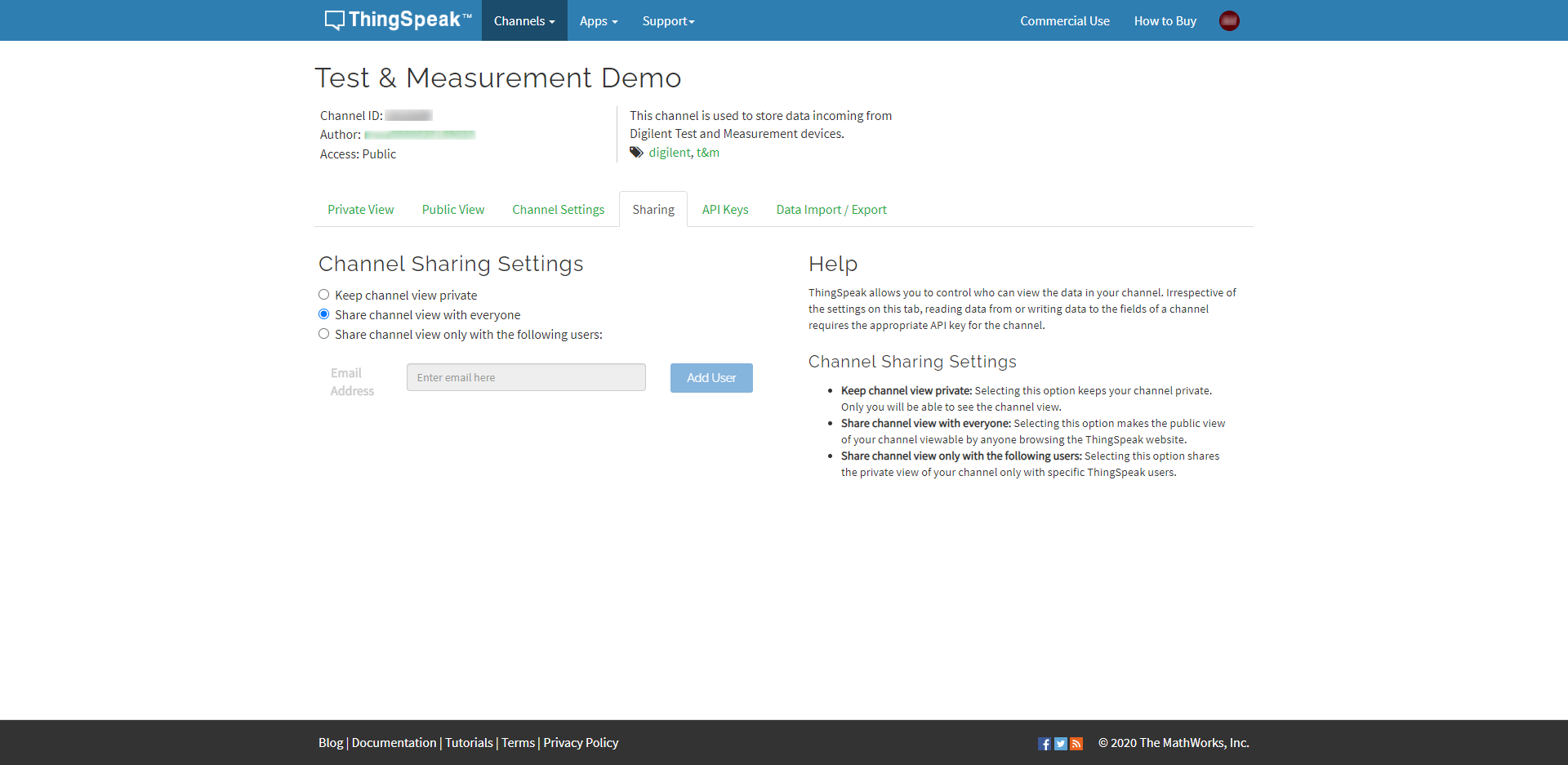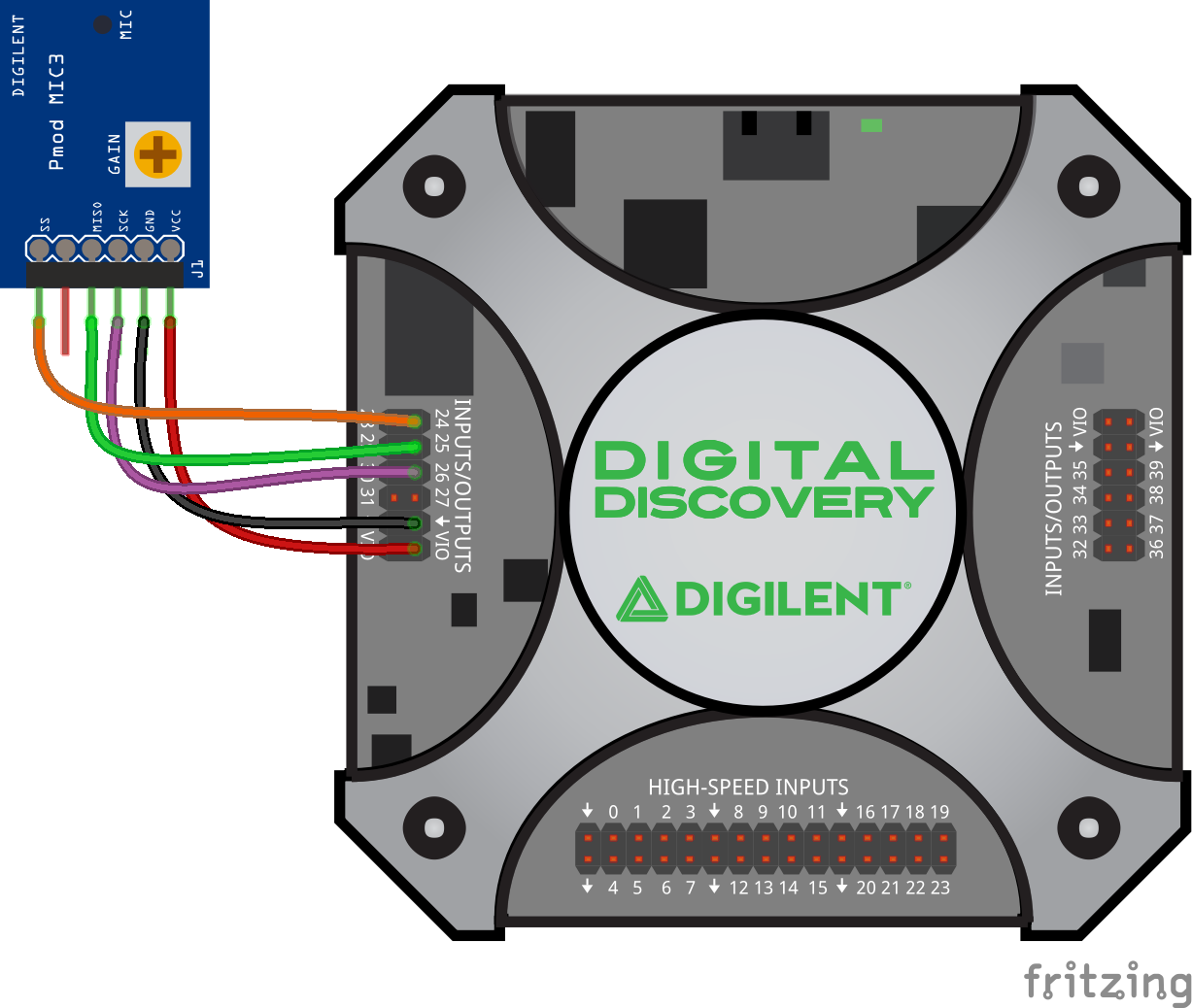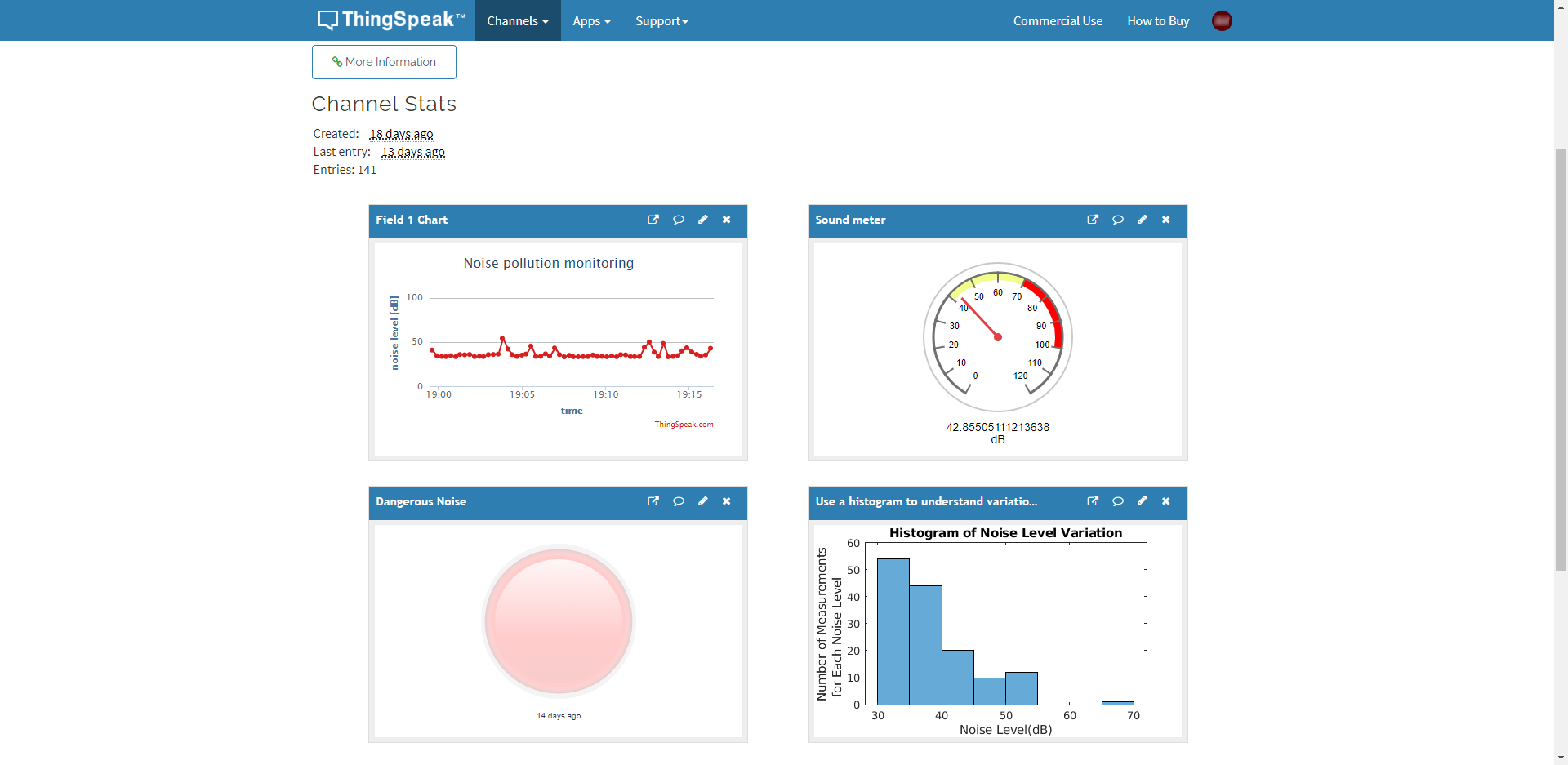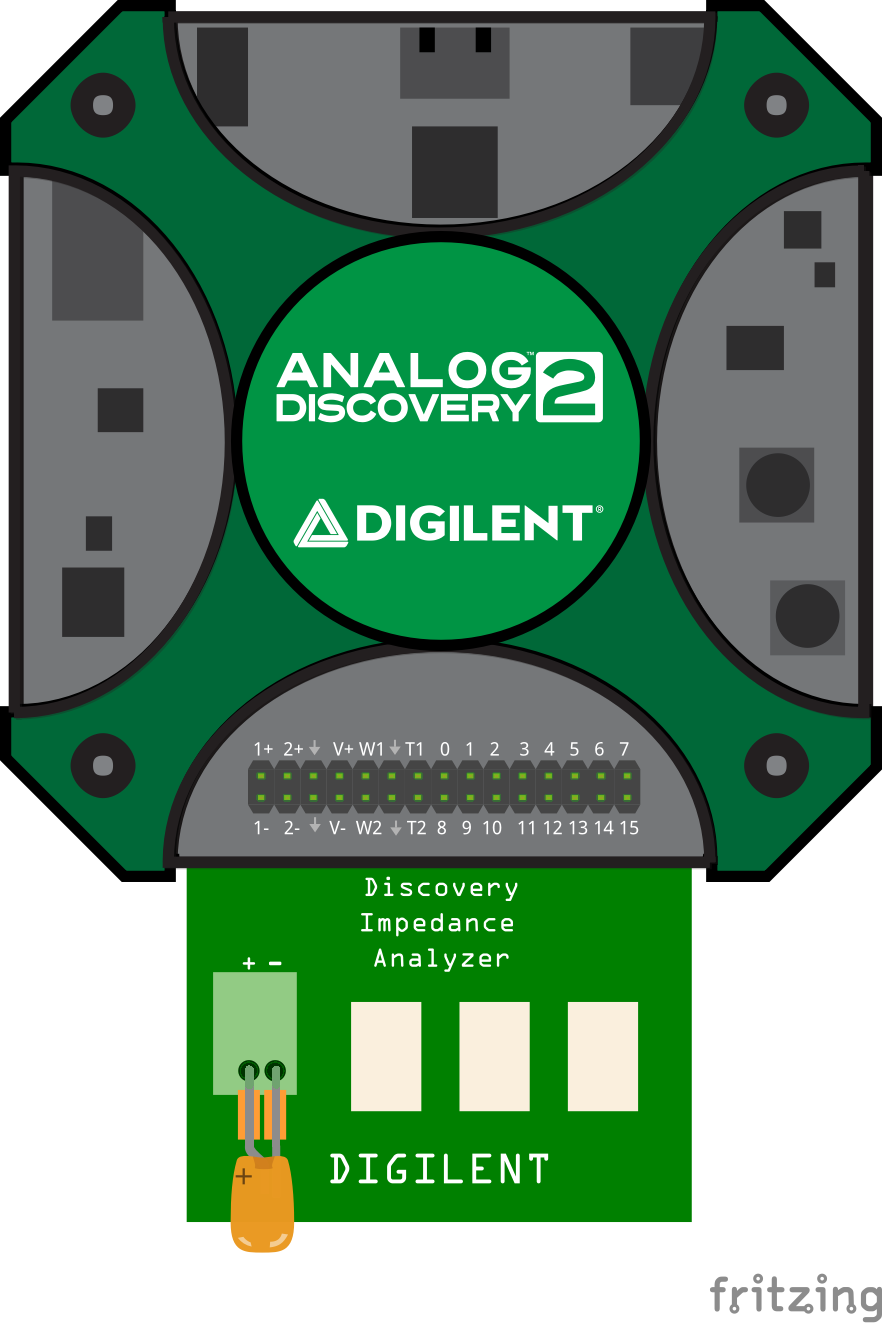Sending Data from WaveForms SDK to ThingSpeak.com
Overview
ThingSpeak, created by MathWorks, is an online platform for collecting, viewing, and analyzing data in the cloud. This guide runs through the steps required to send data captured by your WaveForms SDK compatible Digilent Test and Measurement Device up to ThingSpeak and ends with two optional examples.
One example uses the Pmod MIC3 to capture sound, then, from the measurements, the used Test and Measurement Device calculates the noise level. On the respective ThingSpeak channel, the noise level measurements are visualized in four different ways. The other example uses an Analog Discovery board and the Impedance Analyzer to measure the resistance, the reactance and the capacitance of different electronic components, then post the data on a ThingSpeak channel.
For a detailed description on how to run the noise level measurement example on Analog Discovery Pro in Linux mode, check this guide: Sending Data to ThingSpeak.com with Analog Discovery Pro (ADP3450/ADP3250) in Linux Mode.
Inventory
Hardware
- A Digilent Test and Measurement device
- Pmod MIC3 - used by the Noise Pollution Monitoring example
- Impedance Analyzer for Analog Discovery - used by the Impedance Analyzer example
Software
- Visual Studio Code, or any other editor of your choice
Note: WaveForms can be installed by following the WaveForms Getting Started Guide. By installing WaveForms, WaveForms SDK will be installed, which is needed later in this guide.
Configuring a ThingSpeak Channel
Go to thingspeak.com and sign in or sign up.
Configure the channel settings, name, and fields. The field will be the containers for your data. Configure a field for every data type, you want to store/process.
Under API Keys, note the Write API Key that will be needed to push data to the server from the custom application or script. The Read API Key can be used to access stored data.
When uploading data to a ThingSpeak channel, it will be displayed field-by-filed on different plots. To modify these default plots, or add other data visualization methods to your channel, you can use the visualization or widget presets, you can modify the MATLAB code of the default plots, or you can write your own code to visualize the data.
To make your visualizations/data publicly available, go to Sharing and select the option you want to set. “iframe”-s of certain graphical elements can also be embedded into your webpages.
Examples
To see the usage of the ThingSpeak channels in a project, you can try the examples provided in this guide, or you can create your own examples.
- Noise Pollution Monitoring
-
Hardware Setup
In this example, the Pmod MIC3 microphone module will be used with a Digilent Test and Measurement Device, to measure noise level. The Pmod communicates on SPI interface which will be connected to the Test and Measurement Device's digital I/O lines as follows: SS to DIO line 0 (DIO 24 on Digital Discovery), MISO to DIO 1 (DIO 25 on Digital Discovery) and SCK to DIO 2 (DIO 26 on Digital Discovery). Power to the Pmod is also supplied by the used Test and Measurement Device, so the VCC pin of the Pmod should be connected to the positive supply of the device (VIO on Digital Discovery) and the grounds of the two devices come connected together, as shown in the image to the right.
Software
The complete source code can be downloaded from here: PmodMIC3_to_ThingSpeak.zip. It contains the python script used to control the Pmod MIC3, to convert the measured data and to upload the results to ThingSpeak.
Discussing in detail the usage of the WaveForms SDK is beyond the scope of this project. For more information about it, check Controlling Digital Discovery With LabVIEW, Using the Analog Discovery 2 to Debug Different Motor Controllers, the WaveForms SDK Reference Manual (Legacy) and the examples available in the WaveForms installation directory.
For a demo project with Pmod MIC3, check Using the Pmod MIC3 with Arduino Uno.
At the beginning of the script, the necessary modules are imported, then the address of the ThingSpeak channel is defined. To access your own channel, use your own API key in the address.
DIO lines used to communicate with the Pmod, as well as global variables controlling communication and data processing are also defined here. Before calling any function from the WaveForms SDK, it is necessary to load the dynamic library.
"""import modules""" import sys # This module provides access to some objects used or maintained by the interpreter and to functions that interact strongly with the interpreter import time # This module provides various functions to manipulate time values from ctypes import * # C data types in Python import signal # This module provides mechanisms to use signal handlers import requests # Requests HTTP Library # ---------------------------------------------------------------------------------------------------------- """variables for communication with ThingSpeak""" url = "https://api.thingspeak.com/update?api_key=E**************7" # ---------------------------------------------------------------------------------------------------------- """variables for connections and SPI""" # define the communication frequency in Hz spi_frequency = 1e6 # pin used for chip select (DIO 24 on Digital Discovery) spi_CS = 0 # pin used for master in - slave out (DIO 25 on Digital Discovery) spi_MISO = 1 # pin used for serial clock (DIO 26 on Digital Discovery) spi_SCK = 2 # samples to average AVERAGE = 1000 # ---------------------------------------------------------------------------------------------------------- """load the WaveForms SDK""" if sys.platform.startswith("win"): dwf = cdll.LoadLibrary("dwf.dll") # on Windows elif sys.platform.startswith("darwin"): dwf = cdll.LoadLibrary("/Library/Frameworks/dwf.framework/dwf") # on macOS else: dwf = cdll.LoadLibrary("libdwf.so") # on Linux
For repeating tasks like resetting and closing the used instruments, displaying error messages and reading data on SPI, user defined functions are used. Certain keywords and interrupt handlers must also be defined before using them.
"""function to reset all instruments, close the device and quit""" def close_device(signum=0, frame=0): signum = frame # dummy frame = signum # dummy print("Device disconnected\n") dwf.FDwfDigitalSpiReset(hdwf) dwf.FDwfDigitalOutReset(hdwf) dwf.FDwfDigitalInReset(hdwf) dwf.FDwfAnalogIOEnableSet(hdwf, c_int(False)) dwf.FDwfDeviceClose(hdwf) sys.exit() # ---------------------------------------------------------------------------------------------------------- """function to display the last error message""" def display_error(err_msg="No error"): if err_msg == "No error": err_msg = create_string_buffer(512) dwf.FDwfGetLastErrorMsg(err_msg) err_msg = str(err_msg.value)[2:-1] if err_msg == "": err_msg = "unknown error" print("Error: " + err_msg + "\n") return err_msg # ---------------------------------------------------------------------------------------------------------- """function to read spi data""" def spi_read(): lsb = c_int() msb = c_int() dwf.FDwfDigitalSpiSelect(hdwf, spi_CS, LOW) # activate time.sleep(.001) # millisecond spi_command = c_int(0) dwf.FDwfDigitalSpiWriteRead(hdwf, spi_mode, c_int(8), byref( spi_command), c_int(1), byref(lsb), c_int(1)) # read 1 byte dwf.FDwfDigitalSpiWriteRead(hdwf, spi_mode, c_int(8), byref( spi_command), c_int(1), byref(msb), c_int(1)) # read 1 byte time.sleep(.001) # millisecond dwf.FDwfDigitalSpiSelect(hdwf, spi_CS, HIGH) # deactivate return lsb.value | (msb.value << 8) # ---------------------------------------------------------------------------------------------------------- """keyboard interrupt handler and keywords""" signal.signal(signal.SIGINT, close_device) HIGH = c_int(1) LOW = c_int(0) DwfDigitalOutIdleZet = c_int(3)
Before using a Test and Measurement Device, it needs to be connected to the host computer. To safely connect it, cases in which the device is used by other software, or is not available from some other reason, should be evited.
"""open the connected T&M device""" device_count = c_int() dwf.FDwfEnum(c_int(0), byref(device_count)) # count devices if device_count.value == 0: # terminate the program if no devices are connected display_error("No connected device detected") sys.exit() for device_index in range(device_count.value): # get the name of the device device_name = create_string_buffer(64) dwf.FDwfEnumDeviceName(device_index, device_name) # connecting the device hdwf = c_int() dwf.FDwfDeviceOpen(device_index, byref(hdwf)) # check for success if hdwf.value != 0: break if hdwf.value == 0: # terminate the program if the device can't be connected display_error() sys.exit() # display message device_name = str(device_name.value)[2:-1] print(device_name + " is connected\n")
To start communicating with the connected Pmod, it has to be powered. In devices which support this feature, the output voltage of the power supply should be set to 3.3V, as this is the recommended operating voltage of the Pmod. However, a supply voltage of 5V shouldn't damage the pmod, according to its datasheet.
After the microphone is powered, the SPI interface should be initialized. After setting the communication parameters, a dummy read is performed, to start driving the serial clock.
"""start the power supply""" if device_name == "Digital Discovery" or device_name == "Analog Discovery Pro 3450" or device_name == "Analog Discovery Pro 3250": dwf.FDwfAnalogIOChannelNodeSet(hdwf, c_int(0), c_int( 0), c_double(3.3)) # set digital voltage to 3.3V elif device_name == "Analog Discovery 2" or device_name == "Analog Discovery Studio": dwf.FDwfAnalogIOChannelNodeSet(hdwf, c_int(0), c_int( 0), c_double(True)) # enable positive supply dwf.FDwfAnalogIOChannelNodeSet(hdwf, c_int(0), c_int( 1), c_double(3.3)) # set voltage to 3.3V elif device_name == "Analog Discovery": dwf.FDwfAnalogIOChannelNodeSet(hdwf, 0, 0, 1) # enable positive supply else: display_error("Can't start the power supply. The device is incompatible.") close_device() dwf.FDwfAnalogIOEnableSet(hdwf, c_int(True)) # master enable print("Power supply started\n") time.sleep(5) # seconds # ---------------------------------------------------------------------------------------------------------- """initialize the spi communication""" dwf.FDwfDigitalSpiFrequencySet(hdwf, c_double( spi_frequency)) # set clock frequency dwf.FDwfDigitalSpiClockSet(hdwf, spi_SCK) # SCK pin dwf.FDwfDigitalSpiDataSet(hdwf, c_int(1), spi_MISO) # MISO pin dwf.FDwfDigitalSpiIdleSet(hdwf, c_int(1), DwfDigitalOutIdleZet) # idle state spi_mode = c_int(1) # MOSI/MISO mode dwf.FDwfDigitalSpiModeSet(hdwf, c_int(0)) # CPOL=0 CPHA=0 mode dwf.FDwfDigitalSpiOrderSet(hdwf, c_int(1)) # MSB first dwf.FDwfDigitalSpiSelect(hdwf, spi_CS, HIGH) # CS pin # dummy read to start driving the channels, clock and data dwf.FDwfDigitalSpiReadOne(hdwf, c_int(1), c_int(0), c_int(0)) print("SPI interface initialized\n") time.sleep(1) # seconds
Measurements are done continuously until Ctrl+C is pressed. The results of the measurements are averaged, then converted to dB (this conversion is just an approximation of the true noise level).
The result of the conversion is pushed to the ThingSpeak channel. If a communication error appears, or the process is interrupted, the used instruments are reset, and the program finishes.
"""measure and send data to ThingSpeak""" print("Measuring and uploading data. Press ctrl+c to stop...\n") while True: try: # receive initial data level = 0 # average data for index in range(AVERAGE): level += (spi_read() / 10) / AVERAGE # calculate noise level db = 729.0532027 - level * 0.4239354122 + \ pow(level, 2) * 0.8875384813 * 1e-4 - \ pow(level, 3) * 0.6195715088 * 1e-8 # send data and check for errors send_state = requests.get(url+"&field1="+str(db)) if send_state.status_code != 200: display_error("Can't communicate with ThingSpeak") close_device() except KeyboardInterrupt: # exit if Ctrl+C is pressed break # ---------------------------------------------------------------------------------------------------------- """reset and close the device""" close_device()
Results
The indicators can be added from the channel's Private/Public View, with the Add Visualization, Add Widget, MATLAB Analysis, or MATLAB Visualization buttons.
The measured noise levels can be plotted against time, or displayed on a gauge widget. A histogram of the measured values can also be displayed, along with a virtual LED, to indicate dangerous noise levels. One important MATLAB function to use in data processing is thingSpeakRead().
- Impedance Analyzer
-
Hardware Setup
In this example, the Impedance Analyzer will be used, along with an Analog Discovery board, to measure the resistance, the reactance and the capacitance of different electronic components. In this guide the Impedance Analyzer for Analog Discovery will be used with Analog Discovery 2. If you plan to use the Analog Discovery Studio, or Analog Discovery 2 without the Impedance Analyzer, check this guide for a connection diagram: Using the Impedance Analyzer. To measure the properties of an electronic component, place it in the terminal block of the Impedance Analyzer board.
Software
The complete source code can be downloaded from here: AnalogImpedance_ThingSpeak.zip. It contains the python script used to control the Impedance Analyzer instrument and to upload the measured data to ThingSpeak.
Discussing in detail the usage of the WaveForms SDK is beyond the scope of this project. For more information about it, check Controlling Digital Discovery With LabVIEW, Using the Analog Discovery 2 to Debug Different Motor Controllers, the WaveForms SDK Reference Manual (Legacy) and the examples available in the WaveForms installation directory.
For a demo project with the Impedance Analyzer, check: Using the Impedance Analyzer.
At the beginning of the script, the necessary modules are imported, then the address of the ThingSpeak channel is defined. To access your own channel, use your own Write API key in the address. Before calling any function from the WaveForms SDK, it is necessary to load the dynamic library.
""" DWF Python Example Author: Digilent, Inc. Revision: 2019-10-21 Requires: Python 2.7, 3 Desciption: Performs impedance measurements and pushes to ThingSpeak.com """ from ctypes import * from dwfconstants import * import math import time import sys import numpy import requests url = "https://api.thingspeak.com/update?api_key=8C############BU" if sys.platform.startswith("win"): dwf = cdll.LoadLibrary("dwf.dll") elif sys.platform.startswith("darwin"): dwf = cdll.LoadLibrary("/Library/Frameworks/dwf.framework/dwf") else: dwf = cdll.LoadLibrary("libdwf.so")
Before using a Test and Measurement Device, it needs to be connected to the host computer. To safely connect it, cases in which the device is used by other software, or is not available from some other reason, should be signaled to the user.
version = create_string_buffer(16) dwf.FDwfGetVersion(version) print("DWF Version: "+str(version.value)) hdwf = c_int() szerr = create_string_buffer(512) print("Opening first device") dwf.FDwfDeviceOpen(c_int(-1), byref(hdwf)) if hdwf.value == hdwfNone.value: dwf.FDwfGetLastErrorMsg(szerr) print(str(szerr.value)) print("failed to open device") quit()
Initializing the Impedance Analyzer instrument, with a reference resistor of 1MΩ (the reference resistor of the Impedance Analyzer board) and discarding one measurement to force starting a new one.
sts = c_byte() frequnecy = 1e3 reference = 1e6 capacitance = c_double() resistance = c_double() reactance = c_double() print("Reference: "+str(reference)+" Ohm Frequency: "+str(frequnecy/1e3)+" kHz") dwf.FDwfAnalogImpedanceReset(hdwf) # 0 = W1-C1-DUT-C2-R-GND, 1 = W1-C1-R-C2-DUT-GND, 8 = AD IA adapter dwf.FDwfAnalogImpedanceModeSet(hdwf, c_int(8)) dwf.FDwfAnalogImpedanceReferenceSet(hdwf, c_double( reference)) # reference resistor value in Ohms dwf.FDwfAnalogImpedanceFrequencySet( hdwf, c_double(frequnecy)) # frequency in Hertz dwf.FDwfAnalogImpedanceAmplitudeSet(hdwf, c_double(1)) dwf.FDwfAnalogImpedanceConfigure(hdwf, c_int(1)) # start time.sleep(1) # ignore last capture, force a new one dwf.FDwfAnalogImpedanceStatus(hdwf, None)
Measurements are done continuously until Ctrl+C is pressed. The results of the measurements uploaded to the given ThingSpeak channel. If a communication error appears, or the process is interrupted, the used instrument is stopped, and the program finishes.
print("Press Ctrl+C to stop...") try: for i in range(1000): time.sleep(60) # seconds if dwf.FDwfAnalogImpedanceStatus(hdwf, byref(sts)) == 0: dwf.FDwfGetLastErrorMsg(szerr) print(str(szerr.value)) quit() if sts.value != 2: print("Measurement not done") continue dwf.FDwfAnalogImpedanceStatusMeasure( hdwf, DwfAnalogImpedanceResistance, byref(resistance)) dwf.FDwfAnalogImpedanceStatusMeasure( hdwf, DwfAnalogImpedanceReactance, byref(reactance)) dwf.FDwfAnalogImpedanceStatusMeasure( hdwf, DwfAnalogImpedanceSeriesCapactance, byref(capacitance)) print(str(i)+" Resistance: "+str(resistance.value)+" Ohm Reactance: " + str(reactance.value/1e6)+" MOhm Capacitance: "+str(capacitance.value*1e12)+" pF") r = requests.get(url+"&field1="+str(resistance.value)+"&field2=" + str(reactance.value/1e6)+"&field3="+str(capacitance.value*1e12)) if r.status_code != 200: print(r) break except KeyboardInterrupt: # Ctrl+C pass dwf.FDwfAnalogImpedanceConfigure(hdwf, c_int(0)) # stop dwf.FDwfDeviceClose(hdwf)
Results
The measured resistances, reactances and capacitances are displayed in the console window, as well as uploaded in the cloud. On the ThingSpeak channel the three default plots are displayed for the three data sets in the Private View or in the Public View tab, depending on the sharing settings of the channel.
Next Steps
Now that data can be transferred between the test and measurement device and ThingSpeak, the script can be modified as needed for your project.
For more information on WaveForms SDK, see its Resource Center.
For technical support, please visit the Test and Measurement section of the Digilent Forums.

